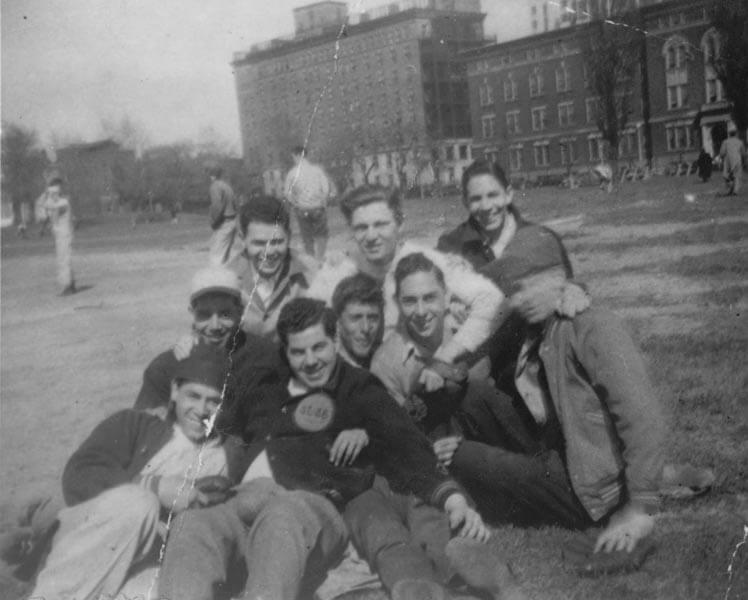Leonard Nimoy
Leonard Nimoy was an actor best known for his iconic role as Mr. Spock on the original Star Trek. He grew up in the West End, and was trained in performance at the Elizabeth Peabody House.
Leonard Nimoy was born on March 26, 1931 to Max and Dora Nimoy, Jewish immigrants from present-day Ukraine. Max was a barber in Mattapan, and Dora a housewife, but the family grew up in a tenement on Boston’s West End. Reflecting tenement life in general, the Nimoys packed three generations (Leonard’s grandparents and the immediate family) into a small apartment. As a child, Leonard frequented the West End House and the Elizabeth Peabody House. The Peabody House had many activities for children, including a science lab, sports, and a theater with 375 seats. Leonard’s older brother, Melvin, enjoyed the science lab and later became a chemical engineer with a graduate degree from MIT, but Leonard preferred the theater, and his first production at the Peabody House was “Hansel and Gretel” at eight years old. At seventeen, he had a part in the local production of “Awake and Sing!”, a play about an impoverished family and their immigrant boarder in the 1930s Bronx. Nimoy recalled that the plot was very close to his own life, and that deeper significance to the arts inspired him to move to California to pursue acting when he was eighteen.
Nimoy lived in Hollywood and by 1951 started picking up supporting roles in lesser-known movies. He also studied at the Pasadena Playhouse for six months, and his speech coach helped him lose his Boston accent in order to get more parts. In 1953, Nimoy served in the US Army Reserve, becoming a Sergeant and spending eighteen months at Georgia’s Fort McPherson. Even in the Army, Nimoy continued to act, directing and starring in “A Streetcar Named Desire” with the Atlanta Theater Guild. He even convinced the Army to let him direct and write radio and television programs for the troops. Upon returning to California in 1955, Nimoy picked up minor parts in some obscure movies and well-known TV shows, including “Dragnet,” “Gunsmoke,” “Bonanza,” “Perry Mason,” and “Highway Patrol” (he did some of this in the early 1950s to be sure). He also taught method acting and worked odd jobs to support his first wife and children until he was cast in a late-1964 pilot episode of Star Trek, before the show premiered on NBC on September 8, 1966. Nimoy played Spock, the uber-logical, half-human/half-Vulcan science officer and first officer of Starship Enterprise, with an iconic, deep voice.
Star Trek was cancelled in 1969 after three seasons, but it attracted a widespread cult following that spawned many Star Trek movies with the original cast, many of which were directed or written by Nimoy. Nimoy had a strong personal identification with Spock because he “was the other, the alien, and I grew up feeling that way” as the son of Jewish immigrants in the West End. Because of Nimoy’s busy schedule on the show, combined with his skill in method acting, he often never stopped feeling like Spock until midday Sundays, only to get back into the studio on Mondays. Spock’s second wife, Susan Bay Nimoy, was also an actor who guest starred as Admiral Rollman in two episodes of Star Trek. After the show’s cancellation, Nimoy acted in two seasons of the TV series “Mission: Impossible,” but he left the show considering a career change to photography. In the West End, a childhood friend taught Nimoy how to make a darkroom out of his own bathroom, and cheaply print photographs with the family camera. Nimoy went to the University of California, Los Angeles to study photography, but he ultimately decided to continue acting. He wanted to be a fine art photographer instead of a commercial photographer, but found that fine art photography was not a stable profession. This did not stop Nimoy from pursuing diverse interests: he published photography books, albums with pop music and spoken word, and even received a master’s degree in Spanish from Antioch University Austin.
Nimoy died on February 27, 2015, at eighty-three years old, from COPD resulting from cigarette smoking, which he quit three decades earlier. In his final years, Nimoy returned to Boston, still feeling a strong connection to the city. In a WGBH interview to promote his “Out of this World” collaboration with the Boston Pops, he noted that his parents were among the last West End residents to leave their building during urban renewal, which led them to eventually move to Dorchester, because they did not want to be forced out of their neighborhood. Because of urban renewal, the West End of today looks far different from the place Nimoy remembered; in the early 1990s, he and his wife could not find the street he grew up on. Yet Nimoy rekindled his connection to the West End in a 2014 documentary, Leonard Nimoy’s Boston, that he made with his son, filmmaker Adam Nimoy.










